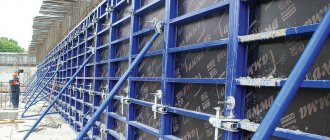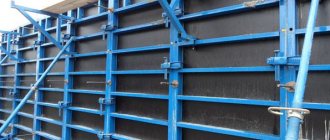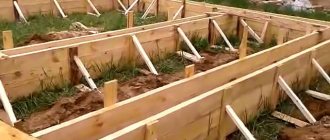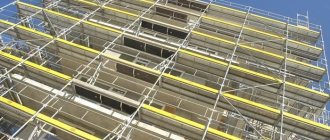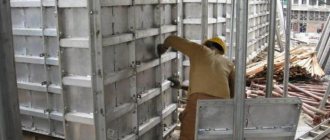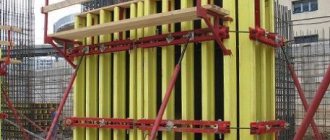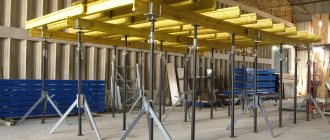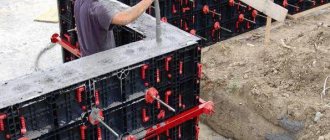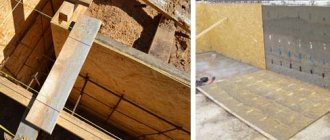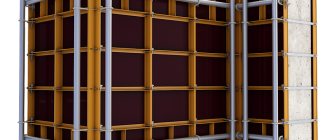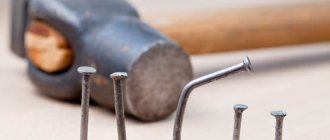Reinforcement based on metal formwork
Unified collapsible formwork is a metal formwork or a combination of metal and wood.
Metal formwork is made of corners, channels and metal sheets 2 mm thick. This formwork design is more durable and therefore practical; metal formwork can be reused almost 200 times. The design of metal formwork allows, if it is a unified collapsible formwork, to assemble and install large-sized formwork panels. The area of these panels can reach 35 square meters. The use of unified formwork allows you to assemble and install rigid formwork blocks and reinforcement and formwork blocks using a crane. In addition to the unified collapsible formwork, there is another form of metal formwork - block form.
A block mold is a steel form, completely removable and rigid, intended for concreting foundations of the same type. Installation of block formwork with a crane. Metal foundation formwork in the form of a block form is installed on the concrete preparation. This form of metal foundation formwork is economical to use for a large number of foundations of the same type.
Block-shaped metal formwork can have a transformable metal formwork design, then it can be used for several standard sizes of foundation. Metal sliding formwork is used for concreting tall structures with a compact perimeter and a plan shape that is constant in height.
How to make metal formwork? The formwork structure consists of formwork panels, which are suspended from a U-shaped jacking frame, jacks and a working platform, suspended scaffolding and oil pipelines. The height of the metal formwork at this moment is usually 1100 - 1200 mm. The formwork design covers the concrete structure along the external and internal contours.
How to make formwork if the cross-section is round? This metal formwork consists of two concentrically located walls, which are attached to the inner and outer circles. To make lifting easier, the metal formwork is tapered. The design of this type of formwork is all-metal, making it more rigid.
Such metal formwork is used repeatedly, i.e. inventory The erection of formwork is carried out using jacks; they rest on jacking rods installed inside the formwork of the structure being erected. The jacks climb the rods and pull the formwork along with them. In block-shaped metal formwork, the working floor is made of wood, it is laid on metal purlins (lightweight) and secured to the uprights of U-shaped frames, and scaffolding for other work is also attached here.
The design of metal climbing formwork is used to concrete high-rise structures in the shape of a cone or rectangular section of different sizes. This metal formwork is made of steel sheets and angles assembled in the form of panels. The design of metal formwork for the construction of reinforced concrete pipes and other conical structures consists of two conical shells.
They are suspended from radial guides, which are attached to a ring frame suspended on hinges by a mine hoist. The outer shell consists of trapezoidal panels that provide a tapered shape. The panels are rigidly fastened at the top using a special lining, and to each other at the side ends using bolted connections.
Inventory metal climbing formwork is used for the construction of high-rise reinforced concrete structures of a conical shape with a variable wall section in height. This formwork can also be used to construct cylindrical reinforced concrete high-rise structures. The lifting of this formwork - its outer panels - is carried out every 2.5 m in height using a special lifting head supported on a mine hoist, or worm hoists fixed in the rack units of a mine hoist located inside the structure under construction.
Internal formwork panels are dismantled every 1.25 m in height and installed for concreting the overlying tier of the structure. Inventory metal dismountable (panel) formwork is used for the construction of high-rise reinforced concrete structures of various shapes - hyperbolic, conical, biconical, cylindrical, polygonal, etc. .
– with constant and variable wall sections in height. The panels of the internal and external formwork are dismantled every 1 m in height and installed for concreting the overlying sections. Rearrangement of formwork panels is carried out from internal steel tubular scaffolds, external suspended scaffolds and from suspended cradles of the unit.
The best that currently exists from plastic formwork, so that the price-quality ratio is optimal, is the product of the Epic Eco company. The products of this company are of European quality - this is Ukraine's number one formwork! The main office is located in Slovenia. If metal formwork, despite its advantages, requires up to 50 revolutions, then plastic formwork up to 500 times.
Epic Eco formwork can be assembled without the use of special tools, by workers without prior training other than passing a safety exam. What is Epic Eco formwork made of? – Made of polypropylene and fiberglass, which gives the structure strength, water resistance, and wear resistance.
What are the advantages of Epic Eco plastic formwork? - Relatively low price. One meter square from two hundred euros. - Not subject to corrosion, warping, swelling. Moisture resistant. - Lightweight. One square meter weighs no more than twenty-two kilograms. - Formwork elements can be used for both horizontal and vertical surfaces.
Reusable formwork traditionally consists of steel or aluminum panels. Reusable metal formwork, compared to aluminum, is susceptible to corrosion, but it is more resistant to mechanical damage. Monolithic structures allow buildings to be erected in a shorter time; their strength characteristics are much higher than, say, panel or brick buildings.
The increased strength characteristics of monolithic buildings make it possible to construct structures that are less voluminous, which reduces concrete consumption. All types of formwork do not require any special conditions for storage and transportation; all these operations can be carried out in the open air and in all weather conditions.
Reusable formwork is an advanced technology in the construction of not only multi-apartment residential buildings and public buildings, but also in the construction of private facilities, swimming pools and other structures. To order, it is possible to produce formwork of any design, with any dimensions, which allows you to build any object at the request of the customer.
Installation of formwork is perhaps the most critical stage in the process of manufacturing a reinforced concrete bathtub. It is the quality of installation and fastening of the formwork that determines how the concrete pouring will proceed. The most common defects with poor formwork: bulging of concrete mass due to pressure, collapse of walls, violation of the geometry of the pool.
We use 21 mm thick plywood as formwork. Of course, the use of reusable metal formwork will simplify the formwork installation procedure, but since almost every pool has its own unique shape, different bottom profile and depth, roundings, it is often easier to get by with disposable formwork.
Some tips from experience1. Do not install embedded elements before pouring concrete. It is better to leave the niches and place them after removing the formwork and leveling the walls.2. Don't skimp on spacers and ties. It is better to install them every 50 cm.3. You can use the wall of the house to which the pool adjoins as external formwork, only through a laid divider. Polystyrene foam 5 cm thick is enough.
You can assemble the structure yourself. But aluminum formwork for rent is also a good option. Installation can be carried out using either individual panels or pre-assembled panels (but no more than 5-6 panels measuring 3x1.2 m).
The elements are connected using coupling screws (with washers and nuts), which are threaded into conical holes in the shield frames. It is recommended to place the tightening screws in a plastic tube. This ensures their reliable protection from the influence of concrete. The length of the plastic tube must correspond to the thickness of the wall being built.
We invite you to familiarize yourself with: Minor repairs to a brick stove for a bathhouse
When installing wall formwork with one tier using panels 1.2-2.5 m high, 2 height screws are sufficient. If the structure is erected from 2 tiers with panels over 2.5 m high, then there should be 3 tension screws on each side. Unused holes are closed with plugs or plastic cones.
Adjacent panels are connected using locks. Their number depends on the height of the elements and the proximity of the joint to the outer corner. When the outer shield is attached, pins are used instead of locks. Horizontal parts are fixed using tightening screws.
To connect the additional elements with the main panels, 2 wedge locks are installed. When installing a structure that is too high (over 2.5 m), the connection to the main panels occurs using wedge locks and leveling beams with pins. Their number depends on the width of the additional panel.
- Installation of formwork begins from the corner of the building. In this case, to begin with, two metal shields are placed, and then the remaining elements can be installed. In order for the shields to hold, it is necessary to install support braces. The braces themselves fix the vertical position of the main formwork element as accurately as possible, ensure the immobility of the created structure, and also minimize possible wind loads that will likely be present during the installation of the formwork.
- In this process, it is best to use braces that have an adjustment mechanism. With their help, we can control the location of the support, while not paying attention to many construction factors. As for fastening the braces themselves, manufacturers often provide special places for these (you can find polypropylene nuts in these places). Accordingly, the nuts are removed, the panel formwork elements are installed, after which the nuts are screwed back on.
- The formwork elements must be properly secured to each other. Most often this occurs on the basis of a tight screw connection. As an additional connection, you can use the most common wood elements. The boards can be placed on the surface of two boards at once, the field of which can be securely secured.
- If we are talking about installing metal formwork for walls, then it can be attached directly to the base of metal reinforcement that protrudes from the concrete foundation. In this case, you can use thick wire, which provides a quite good connection in order to carry out construction work without any problems.
- Immediately after installing each panel, the support braces are installed. This is necessary for the reason that under the large weight of the structure it can simply collapse. The braces themselves can be located either on the area of a specific shield, or between two shields. Both options are quite good, but the most important thing is to follow the step.
- Another important issue is the creation of openings. When building foundations, such solutions are not used so often, but when creating walls it is simply necessary. Accordingly, at the openings it is necessary to use a cut panel element. Most often, such components have modest dimensions, so there is simply no need for support braces. If, for example, a window opening is created, then it is necessary to create a support zone on the side metal panels. In this case, it will be a kind of groove for a shield of non-standard dimensions.
To increase the number of rotations of the boards (up to 10 times or more), it is recommended to use boards designed by N. I. Gakhov for wall formwork, in which the stitching strips are attached to the board (except for nails) with steel strips
Formwork of strip foundations for building walls. With a foundation height of up to 0.2 m, the formwork for them is made of two parallel boards 40-50 mm thick. The boards are held in a vertical position by stakes driven into the ground and spacers made of bars inserted between these boards.
When the height of the foundations is from 0.2 to 0.75 m, their formwork is made of panels; the lateral pressure of the concrete mixture is perceived either by pressure boards and struts, or by clamps that compress the form from above and from the sides. The position of the foundation in plan is fixed by guide boards fixed to the ground or concrete preparation. The guide board is fixed to the ground using stakes driven into the ground. When installing boards on preparation (or on the floor), wooden plugs are placed in fresh concrete to secure them. The cork consists of a piece of board into which nails 80-100 mm long are driven to approximately half their length. The protruding ends of the nails (with heads) are immersed in fresh concrete and, when the latter sets, firmly hold the plug from accidental shifts.
The formwork of strip foundations with a height of more than 0.75 m is performed as wall formwork
Formwork of walls and massifs. Wall formwork is carried out in the form of two parallel walls made of horizontal panels. For small wall heights (up to 6 m), vertical panels can be used.
The distance between the formwork panels should be equal to the design thickness of the wall being built. With a wall thickness of up to 0.5 m, the boards are supported by ribs.” Formwork for walls of greater thickness, as well as the formwork of walls on the surface of which high demands are placed (regardless of their thickness), must be reinforced with contractions perpendicular to the ribs. The lateral pressure of the concrete mixture is perceived by ties connecting the opposing ribs or scrums. Maintaining the design thickness of the walls is ensured by installing temporary wooden spacers between the panels, which are removed during concreting. Instead of temporary spacers, you can use hollow concrete bars placed on the tie bolts. It is recommended to make the ribs or ribs through which the bolts are passed from two boards connected by wooden spacers on nails. This makes it possible to avoid drilling holes for bolts and allows the bolts to be placed anywhere along the length of the scrum.
The position of the wall formwork in plan is ensured by installing guide boards. The inner (facing the concrete) edge of the guide board should lie in the plane of the wall surface, and the front (facing the concrete) surface of the shield should coincide with this edge.
The verticality and lateral stability of the wall formwork is ensured by installing struts every 3-4 m along its length.
Mass formwork (foundations for heavy equipment, industrial ovens, etc.) is arranged in the same way as wall formwork. When the width of the massif is more than 3 m, horizontal tie bolts are replaced by inclined ties secured to anchors embedded in the underlying layers of concrete.
Formwork made of large-panel panels. For structures with large formwork surfaces (large foundations for equipment, columns of large sections, smooth walls, etc.), large-panel panels can be used. They are enlarged elements of collapsible formwork, in which the deck (sheathing) is combined into one whole with supporting ribs and ties. Thanks to this consolidation, it becomes possible to mechanize formwork work - installing and removing panels with cranes. The weight of large-panel panels ranges from 0.5 to 2 g and is selected depending on the lifting capacity of the crane equipment available at the construction site. The area of large-panel panels reaches 30 m.
An example of a large-panel wooden panel is shown in 4.
The covering of a large-panel panel is usually made of boards 40-50 mm thick, the ribs are made of thick boards laid on the edge, or from bars, and the scrums are made from bars with a cross-section of 150X150 mm or more. The shields are equipped with devices for mooring when lifting, moving, installing and removing them using a crane. These devices consist of loops, hooks or special clips. On the board shown in 4, for this purpose, on the upper horizontal scrum there are clips for attaching the formwork lever, and in the lower part of the board on the deck there are plates (wooden or steel) fixed to support this lever when stripping the underlying board
The consumption of materials for formwork made from large-panel panels is higher than for conventional collapsible formwork. The cross-sections of the shield elements (ribs, contractions) are assigned larger than required by calculation, i.e. dynamic loads are taken into account (impacts and other random impacts when moving panels with a crane, when they are torn off from concrete, etc.). The main advantage of large-panel formwork is that the mechanization of installation and dismantling of such formwork dramatically reduces labor costs and speeds up the pace of work. It is advantageous to use large-panel formwork when turning it multiple times.
Formwork of foundations for columns. The formwork of rectangular foundations for columns (5,a) is made of two pairs of panels forming a box. One pair (the so-called “mortgage” boards) has a length equal to the length of one of the sides of the foundation, and the other pair (the so-called “cover” boards) is 200-250 mm longer than the other side. At the ends of the covering panels, stop strips are sewn to fix the position of the embedded panels and absorb the lateral pressure of the concrete mixture transmitted to them. Opposite panels are connected with wire ties; embedded panels are secured with temporary spacers, which are removed during concreting. The number and dimensions of nails for fastening the thrust strips are determined by calculation depending on the height of the column step.
The formwork of stepped foundations for columns (5,6) is made from the same boxes as the formwork of rectangular foundations. But for the boxes of the upper steps, the lower boards of the covering panels are made elongated so that the upper boxes rest on the boxes of the underlying steps. The upper boxes are attached to the lower ones with mounting nails. The position of the lower boxes in plan is fixed with stakes driven into the ground.
The “glass” for the subsequent installation of a prefabricated reinforced concrete column is arranged using a special box installed on the formwork of the upper stage of the column.
Formwork of rectangular columns. Column formwork is made in the form of a box of two pairs of panels. The width of the embedded panels is equal to the width of one of the sides of the column, and the covering panels are wider than the other side by twice the thickness of the formwork boards. The height of the boards is fastened with a minimum number of mounting nails.
The lateral pressure of the concrete mixture is perceived by clamps that compress the box. When the formwork turnover is high, stock steel clamps are used, and when the number of turns is low, wooden clamps with thrust strips, fastened with wedges, are used. The branches of steel clamps have holes for fastening wedges, which allows them to be used for columns of various sections. The dimensions of wooden clamps can be changed by nailing additional inserts on their branches
The position of the column formwork in plan and height is fixed by a frame fixed to the column support
or on the ceiling. At the bottom of the column formwork, a hole is made in one of the covering panels for cleaning the box. Before concreting, this hole is closed with a door nailed to the box.
In the boxes of columns supporting beams and purlins, cutouts must be provided for inserting the formwork boxes of these beams and purlins.
Formwork of a monolithic floor slab. The slab formwork consists of panels laid on circles without nailing. The circles rest on subcircular boards, sewn to the side panels of the beams or the ribs of the wall formwork. The length of the circles should be 20-30 mm less than the clear distance between the surfaces of the formwork of the structures on which the slab rests (so that the circles are not pinched by the lateral pressure of the concrete mixture when concreting these structures). The circles are made from boards installed edgewise, or from bars and fixed in the right places, holding them in a vertical position with the help of “frieze” boards located around the perimeter of the slab. The frieze board is laid flat on the end of the panel and on the edge of the side panel of the beam (or wall), nailed with one small nail (50 mm long) to each stitching strip of the panel and to the end of each panel.
With a small number of turns of the formwork (1-2 times), it can be made from separate boards, each of which is nailed to the circles with one nail 50-60 mm long through one circle. In adjacent boards, the nails are spaced apart to facilitate removal of the circles during stripping.
Formwork of beams and purlins. The formwork of the beams consists of side panels and a bottom located between them, supported by the head of the racks or other supports. The side panels are pressed to the bottoms with boards nailed to the box supports. It is not allowed to knock down the side panels and bottoms with nails in order to avoid difficulties when dismantling the formwork. As mentioned above, in the presence of a monolithic floor slab, subcircular boards are nailed to the side panels of the beams to support the circles, supported by supports above the box supports. In the side panels of the purlin formwork boxes, cutouts are provided for inserting the beam formwork.
Instructions for the installation of nail connections and joints of formwork elements. When developing formwork projects, nail joint designs must be carefully considered. The drawings indicate the number, sizes of nails and their location in the nodes. Nails must withstand the loads transmitted to the node, but their number and size should not be exaggerated. It must be remembered that every extra nail, as well as a too long or thick nail, makes it difficult to disassemble the formwork, spoils the boards and thereby reduces its turnover. When using inventory formwork parts, you should generally avoid using nails, replacing them with connections on bolts, clamps, etc.
Nails work well for cutting, but much worse for pulling out. This property of nail connections must be used when designing formwork and scaffolding units, namely: nail connections in the formwork must be designed so that when accepting loads, the nails work for shearing, and when stripping, for pulling out. 8 shows the work
nails securing the pressure board to the beam box or purlin. Arrows (8,a) show the forces arising from the lateral pressure of the concrete mixture; these efforts tend to move the pressure board, which is prevented by the shear nails. When removing the pressure board during stripping (8.6), the nails work to pull out, i.e., they provide the least resistance to the worker’s effort.
Mounting nails, which do not bear design loads and serve only to secure the formwork elements, should be of minimal size, and their number should be limited, if possible. Wherever possible, mounting nails should not be driven completely into the board, leaving a gap of several millimeters between the surface of the board and the nail head, which makes disassembling the formwork easier.
Difficulties in stripping are often caused by improper design of the joints of the formwork elements. The panels, adjacent at an angle, are brought close to each other and fastened with nails (9, a). The panel that must be removed first is clamped by the pressure of the concrete and secured with nails that work during shearing when stripping. The end of the shield is in direct contact with the concrete, which penetrates into the spaces between the wood fibers, making it difficult to tear off the shield. In addition, the end of the shield often extends 1-2 mm into the concrete. All this causes breakdowns of shields; with this design
Formwork joints inevitably require large labor costs during formwork stripping.
Along the end of this shield (with nails driven in from the side facing the concrete) a block is sewn, protruding 50 mm beyond the end line; a shield is leaned against this block (without nailing), the end of which is flush with the edge of the block. The quarter formed between the ends of the shields is closed with a chamfered strip. The lath is attached to the block with two or three nails 50 mm long. At
When stripping, first remove the block (while the nails work to pull it out), then the lath. As a result of this, the ends of both panels are released, which, after removing the fastenings, freely move away from the concrete. According to this principle, it is necessary to arrange the joints of beam boxes and purlins with column boxes and among themselves, joints in the corners of the intersection of walls, entering corners in the formwork of foundation masses, etc.
Materials
Collapsible metal formwork includes panel elements and fasteners. Assembling such formwork is quite simple and quick - it can be compared to assembling a children's construction set. The panels are connected to each other using special fasteners and they can be positioned relative to the plane either vertically or horizontally. The advantages of such formwork are perfectly smooth and even walls, but there is also a disadvantage - the high price.
Having determined that the future formwork structure will be made of metal, which should also be easy to assemble and disassemble. It must be said that such a prefabricated formwork design puts forward a number of requirements for the material from which it is made - it must be characterized by indispensable rigidity and, of course, durability. Such metal material must meet the following requirements:
- The thickness of the sheet metal should be about 2mm. For the foundation, formwork made from panels measuring 2000x500mm will be especially convenient. Also, the work may require shields with dimensions of 1.0-1.5 m.
- To make the formwork frame you will need a profile pipe.
- To make limiters that will set the thickness of the foundation, you will need to take a pipe with a diameter of ½ inch.
- The reliability and strength of the formwork rests on bolts and studs with washers and nuts.
Traditionally, for many centuries, construction formwork was made from wood. The material, easy to process, was used mainly as formwork for foundations. Today, wooden formwork is used mainly in private, small-scale construction and is not used in the construction of large objects. Significant disadvantages of wooden formwork are low load-bearing capacity and the inability to use it repeatedly.
Metal formwork is widely used in modern construction. The material used in the production of formwork is low-carbon steel (oxidized, galvanized, painted) or aluminum. Metal formwork today is the most convenient and technologically advanced for the construction of any, even the largest and most complex architectural objects.
Expanded polystyrene formwork is permanent. Mainly used in private and small-scale construction. Fixed polystyrene foam formwork partially insulates and soundproofs the building. The disadvantages include the complexity of the work, the price and the impossibility of repeated use.
Metal
Structures made from metal sheets are the strongest and most durable. However, they are more expensive than other analogues. Among the advantages of this material, it is worth highlighting its plasticity, thanks to which it is possible to make a formwork structure for columns and other structures of a round type.
Such sheets come in metal and steel. Each of the materials has its own advantages and disadvantages.
Tree
Wooden structures are considered the cheapest, but their durability leaves much to be desired. If you are preparing removable formwork for personal or one-time use, then this option is the best. However, if we are talking about formwork for reusable use or for rental, then it is better to give preference to structures of a different type, since the turnover of wooden frames according to GOST is 30 times.
The materials used for structures of this type are plywood (birch, coniferous or laminated), wide and thin boards. If a frame is needed for the construction of a small country house, then you can ignore the grade of wood and choose the cheapest edged board.
Formwork structures made from polymer panels are gradually gaining popularity, since they weigh much less than their metal counterparts, are not subject to corrosion and do not have all the disadvantages of wooden frames. It is very difficult to make such formwork yourself, so they are usually rented.
Available materials
If finances do not allow you to make wooden formwork or rent a ready-made structure, then you can build a frame from any durable objects with flat surfaces. Sheets of slate or chipboard and even profiled panels are suitable for this. The main thing is that there are no cracks in the finished formwork, otherwise concrete milk will seep through them and the foundation or walls will lose strength.
The main advantage of such formwork is free building materials, the disadvantage is unreliability.
We suggest you familiarize yourself with: Buy a reflective screen with a side for a bathhouse stove at a low price
So, the best materials for frames are wood and metal. Now you need to decide on the type of formwork.
Inventory formwork for monolithic construction
There are two areas of work on the construction of reinforced concrete structures:
- use the factory version of the formwork;
- develop the design under site conditions.
The first decision is most often made during the construction of large projects. In this case, a multifunctional product is used. The dimensions of the formwork structure must change based on the needs of the owner. For this purpose, special mounting holes are made in the shields with a certain pitch. By fixing the bolts in various cells, you can adjust the dimensions of the product.
All factory models are designed for certain operating conditions. This must be indicated on the certificate. In addition, each of them has a maximum permissible load.
Making formwork yourself has a number of advantages:
- calculation for real load, without additional load-bearing capacity;
- use of production waste;
- the ability to think through production based on the parameters of a specific object.
The product is made mainly from:
- become;
- aluminum;
- wood;
- PVC;
- chipboard;
For less adhesion of the surface to the solution, it is covered with plastic film. In addition to the panels that prevent the solution from spreading, the inventory formwork includes:
- racks;
- clamps;
- fastenings;
- formative frame.
The selection of all elements during manual assembly must be carried out in accordance with calculations. Often, purchasing removable formwork is replaced by renting it. This is cheaper and gives variety for different objects.
Design features of metal formwork
To create metal formwork, sheets 1-2 mm thick are used. Despite the high cost, the use of this material has its advantages. These include:
- foundation installation of any configuration;
- additional waterproofing;
- versatility;
- creating a completely smooth surface;
- ideal for monolithic and strip foundations (due to reinforcement welded to the formwork);
- simplicity of cladding (with a significant elevation of the base of the house above the ground);
- maximum rigidity;
- ease of installation work.
Steel formwork has the following technical characteristics:
- shield height – 0.6-3 m;
- their width is 0.25-1.2 m;
- frame turnover is up to 300 cycles, deck turnover is up to 80 cycles;
- deflection – no more than 1/400 of the span;
- concrete pressure – 75-80 kPa.
The frame is a rectangular frame with internal crossbars to increase rigidity. A sheet of construction laminated plywood is installed inside the frame. The ends of the plywood sheet are recessed into the metal profile, the gaps are sealed with sealant (to prevent moisture from entering).
Formwork panels are assembled into a single system using auxiliary equipment: to install the formwork in a vertical plane, support brackets (one- or two-level) are used, and the panels are tied together with special locks (for both horizontal and vertical assembly). At the top of the formwork system, platforms are attached to the panels for the convenience and safe operation of personnel.
Versatility
Metal formwork can be used for the construction of architectural objects of any complexity, including multi-storey buildings. In this case, the same sets of formwork equipment can be used to fill different surfaces (for example, walls and columns).
Metal formwork is more expensive than wooden formwork, but unlike it, it can be used many times (dozens of times before repairs and hundreds of times throughout its entire service life), which significantly reduces the unit cost of construction work. Hundreds of objects can be built using the same formwork kits.
Moreover, today it is not at all necessary to buy construction formwork. Many companies specializing in the production of formwork systems offer their clients services such as formwork rental and leasing (financial lease). That is, even during one-time construction, you can profitably use metal formwork.
Thanks to a well-thought-out design, formwork panels can be assembled into a single system easily, quickly and with high precision. At the same time, the resulting concrete surfaces are of high quality - they are even, flat and smooth.
Metal formwork has high strength and rigidity and can withstand the pressure of building mixtures well. The load-bearing capacity of steel formwork is significantly higher than that of similar wooden formwork; accordingly, this design allows for much larger volumes of concrete to be poured. Aluminum formwork is slightly inferior to steel in terms of rigidity and strength, but has a lower specific weight, which makes it easier to transport and install.
Maintainability
The main elements of removable formwork are laminated sheet plywood and a metal frame. The weaker link is the plywood sheet. Typically, construction plywood can withstand several dozen pouring cycles, after which it is simply replaced with a new one. Minor local defects on the surface of the plywood sheet can be repaired directly on the construction site (cutting the defect, puttying, stripping and painting).
The metal frame is also repairable. Minor damage can be corrected directly on site. If the frame is severely deformed, its individual elements have failed, or welds have burst, the formwork can be repaired in a workshop or small machine shop.
You need to know that as many as 3 types of formwork structures are used in construction. Each option can be used in one or another construction, but you need to take care of choosing the most suitable type in advance.
- Large panel design. In this case we are talking about formwork, which is assembled from really large panels, as well as a special holding frame. This design is used if it is necessary to fill a huge section of the base with concrete with the simplest geometry. Most often, this design consists of 8 shields that form the boundaries of the tape.
- Small panel design. Such formwork elements are used if we have a complex geometry of the structure being created. Accordingly, quite a lot of shields will be required to form a concrete structure, but everything depends directly on the scale of construction, as well as the subtlety of the work being carried out.
- Reversible design. Accordingly, it is advisable to use such formworks in the construction of architectural structures, as well as small houses that must have original elements (columns, supporting walls for terraces).
Based on the type of base, the formwork is:
- Fundamental - used for the construction of strip and slab type foundations.
- For floors - used in the process of pouring basement and interfloor dividing structures.
- Wall – formwork for walls of any type.
If we talk about the design of the formwork frame itself, it can be:
- Large shield. In this case, large wooden or plywood panels are used, which form a strong frame with the smallest number of cracks. Such structures are suitable for pouring large areas and foundations of the correct geometric shape.
- Small shield. This design is more suitable for structures with complex geometry. Thanks to the large number of small parts, they can be laid in any way you like. Most often, the elements of small-panel frames are made of more plastic polymer materials.
- Repositionable. Such designs can be volumetric or block-adjustable. Adjustable formwork is used for large structures, support columns, well shafts, and tunnel walls. In designs of this type, one of the sides is missing.
The first option is most often used in the construction of country houses and other low-rise buildings.
Small shield and large shield
To decide which type of frame is more suitable for a particular project, it is necessary to take into account the design features of these “forms”:
- Large panel formwork. This formwork system is suitable for the construction of long wall openings. The height of one formwork panel can reach up to 0.3 m (and if we take into account the locks and leveling bars, then 1 m). Such panel formwork is characterized by the greatest strength, which allows concrete to be poured continuously. This significantly reduces construction time. However, its use requires specialized lifting equipment.
- Small panel formwork. This type of system allows you to form a frame for structures with complex geometries. The height of one shield in this case is about 200 cm. This is quite enough for the construction of both low-rise and more serious structures. At the same time, the shields can be easily installed in horizontal and vertical positions.
For the construction of fundamental foundations or walls with the correct geometry, it is more convenient to use large-panel formwork, and when constructing complex architectural objects it is better to give preference to small-panel systems.
It is also necessary to decide on the material from which the frame will be made.
Advantages and disadvantages of metal formwork
To make removable formwork reliable with your own hands, you need to calculate the consumption of lumber.
Formwork calculation
In order to calculate how much lumber is required, it is enough to divide the perimeter of the future foundation by the length of the board. After this, divide the height of the formwork by the width and multiply the resulting numbers. On average, about 40-50 boards are required per 1 m3 of concrete solution; a more accurate figure depends on the thickness of the foundation and its type.
Healthy! Let's say we use dry pine boards 25 mm thick, the height of the formwork is 300 mm, and the perimeter of the foundation is 9 m2. In this case, about 0.1 m3 of wood and 30 supports (for the internal and external walls of the formwork) will be required, which will be placed in increments of 0.7 m.
Installation of formwork
It is best to use factory-made boards with a standard length of 6 m, a width of 20-30 cm and a thickness of 25 mm. You will also need to purchase 50 x 50 mm bars to secure the main structural elements.
Then all that remains is to figure out how to make wooden formwork. For this:
- On the ground, prepare the formwork panels by connecting the required number of boards, based on the height of the structure. Since the formwork consists of two parallel walls, panels must be made for both sides at once.
- Make sure there are no large openings in the panels. If you find cracks up to 5 mm thick, you can fill them with tow. Larger holes are clogged with slats.
- Screw sharpened bars to the panels, which will subsequently be driven into the ground.
- Fasten the formwork panels with wooden jumpers in increments of 50-100 cm.
- Additionally, tighten the walls of the formwork structure with hardware to make the frame rigid.
- Install the formwork in a vertical position, and install braces and stops from bars and boards.
- The frame should be made of two rows of belts - lower and upper. The first one will take the main load from the concrete solution, so it is located at a height of about 10 cm. For the upper belt, you can use longer braces and stops that will support the frame at a height of about 40 cm from the ground.
- Cover the inner surface of the formwork with polyethylene to prevent possible leaks of the solution, to protect the boards and ease their subsequent dismantling.
We invite you to read: How to make formwork for pouring walls with your own hands? Technological process and types for erecting walls: tips for assembling the structure Photo and Video
The installation process of such formwork is demonstrated in detail in the video.
After pouring the concrete solution, you must wait 15-20 days. However, everything depends on weather conditions and humidity. After this, you can remove the formwork structure and fill the gaps formed between the foundation and the pit with soil.
For a metal frame, it is necessary to use sheet material with a thickness of at least 1 mm, pipes with a cross-section of 2 x 2 cm and corners.
The sheets are attached to the frame using metal freezes (spot welding can be used). In this case, an external sheathing of 20 x 20 or 40 x 40 cm is formed based on the thickness of the sheet material.
The formwork itself is fixed by spot arc welding.
Ready-made metal formworks can be immediately used in the construction process. In fairly small construction projects, owners tend to use wood formwork, which, of course, can only be used once. The thing is that wood elements are quite easily deformed and completely become unusable after colossal loads.
In large constructions, it is simply necessary to use metal formworks, which can easily withstand heavy loads and also create an ideal surface for the concrete foundation.
Builders also choose metal forms because they are foldable. They can be stored in fairly confined spaces and can also be transported on small trucks. Accordingly, there should not be any problems with transportation. Of course, this only applies to the construction of small buildings. In other cases, truly massive structures are used, which are delivered only with the help of special equipment.
- Perfectly smooth surface. Unlike wood, which can have many irregularities, metal formwork has a really high-quality and smooth surface. Accordingly, we get a high-quality foundation that will not have any external flaws.
- Elementary stripping. For novice builders, a rather serious problem is the removal of formwork after pouring concrete. In this case, a wooden structure can present many unpleasant surprises. With a metal structure everything is elementary simple. With the proper approach (lubrication of surfaces), the formwork can be dismantled in the shortest possible time.
- Strength and rigidity. As we have already said, a metal base for formwork is an ideal option, since in this case we are confident in the solidity of the structure, which certainly will not collapse under the pressure of the concrete mixture. This is a clear advantage compared to wood formwork.
- Durability. Large construction companies that regularly build foundations use the same metal formwork. Of course, over the course of many years they practically do not deform in any way, so you can be sure that the formwork will last for a very long time. If you are building a small private house, you can try to rent formwork from some organization involved in construction.
Many modern metal formworks have special coatings that make the formation of corrosion impossible.
Of course, there are many other small advantages, but most of them relate to the specifics of using certain materials as the basis of formwork.
If we talk about the disadvantages, it can be noted that metal formwork has a large specific gravity. This suggests that in artisanal conditions it will be quite difficult to use a metal product. In large constructions, the formwork can be lifted and moved using special devices, so this problem concerns only those owners who want to carry out the construction with their own hands.
I would also like to note that you can find aluminum formworks on sale that have a more modest weight than other options. However, as it became known, in order to repair such formwork, it is necessary to use argon welding.
Already on the basis of the above information it is possible to determine whether there is a need to use metal formwork.
It should be noted right away that creating metal formwork with your own hands is incredibly difficult. Most often, owners who want to build a house use wood in this case. Based on wood, you can create quite good formwork, while forgetting about large financial expenses. Do not forget that in case of problems, such formwork can be easily broken and remade.
When erecting a metal structure, you may encounter a number of problematic issues. Do not forget that in this case you need to have a lot of special metal profiles, as well as devices that will allow you to fully fasten all the necessary elements. In addition, the cost of such a structure is very high, so it often makes sense to purchase ready-made formwork directly from the manufacturer.
Often, reinforcement is installed along the entire length of the wall formwork. You should take the installation of reinforcement at the corners of the structure especially seriously. In this case, L-shaped clamps will be required to protect the corner from concrete pressure. A jack is used at the ends of the walls, which is necessary for tensioning the reinforcement.
As for the placement of long reinforcement in the formwork elements, here you can use 2 tips at once:
- Before installing the fittings, you can install a small tube that has a slightly larger diameter than the metal rod itself. Then you can stretch the reinforcement through the pipe without any problems. It must be kept in mind that the pipe must be plastic.
- Another good option is to install reinforcement directly during the installation of metal panels. The essence of this idea is that you can use a large number of rods that gradually move forward, thereby simplifying the construction process.
Versatility
Types of panel formwork
Panel formwork is classified according to different criteria, which are presented in the table below along with the types of formwork.
| № | Classification criterion | Types of formwork |
| 1 | material used for manufacturing | plastic, wood, metal |
| 2 | shield size | large-panel (with an area of one structural element from 2 to 4 m², and for decks - 20 m²) and small-panel (up to 2 m² in size) |
| 3 | installation method | sliding, adjustable, horizontal sliding |
| 4 | appointment | for vertical, vertical and horizontal planes |
In practice, permanent versions of panel formwork structures are also used. They are used to simultaneously insulate the walls. Often such varieties are used for foundations. They also further strengthen the base.
Plastic forms
Removable types are used repeatedly. Dismantling is carried out only after the monolith has gained the required strength.
The most affordable and easiest to install is wooden formwork. Panel structures can be easily made from boards with bars with your own hands. The disadvantage of this material is its sensitivity to moisture. In order to use shields repeatedly, they need to be well protected from the negative effects of water, as well as substances contained in the solution.
The metal variety is made from aluminum or steel sheets. The latter type has a high price and significant weight, so it is not used by individual developers. Often installation requires the use of lifting equipment.
Steel panels are used mainly on large construction projects. Such products are characterized by high strength, wear resistance, and a long service life.
The aluminum analogue weighs lighter than steel, but under significant load the form bends.
The easiest option for pouring molds are plastic products. Their use ensures the highest productivity in construction work. This type is often used in the construction of high-rise buildings. Structures of various shapes are assembled from plastic shields.
Often in practice, formwork elements are made of plywood with a thickness of 2 cm or more (depending on size).
Changing the position of sliding formwork elements occurs without disassembling it using special jacks.
During construction, large-sized panel structures are combined with smaller elements. This allows you to build several different walls at the same time.
